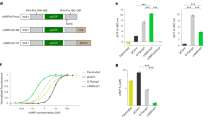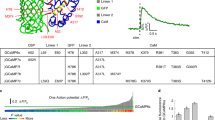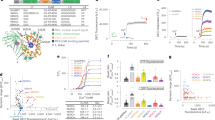Abstract
We report ultrasensitive Ca2+ indicators, yellow cameleon-Nano (YC-Nano), developed by engineering the Ca2+-sensing domain of a genetically encoded Ca2+ indicator, YC2.60 or YC3.60. Their high Ca2+ affinities (Kd = 15–140 nM) and large signal change (1,450%) enabled detection of subtle Ca2+ transients associated with intercellular signaling dynamics and neuronal activity, even in 100,000-cell networks. These indicators will be useful for studying information processing in living multicellular networks.
This is a preview of subscription content, access via your institution
Access options
Subscribe to this journal
Receive 12 print issues and online access
$259.00 per year
only $21.58 per issue
Buy this article
- Purchase on Springer Link
- Instant access to full article PDF
Prices may be subject to local taxes which are calculated during checkout



Similar content being viewed by others
References
Paredes, R.M., Etzler, J.C., Watts, L.T., Zheng, W. & Lechleiter, J.D. Methods 46, 143–151 (2008).
Kotlikoff, M.I. J. Physiol. (Lond.) 578, 55–67 (2007).
Stosiek, C., Garaschuk, O., Holthoff, K. & Konnerth, A. Proc. Natl. Acad. Sci. USA 100, 7319–7324 (2003).
Wallace, D.J. et al. Nat. Methods 5, 797–804 (2008).
Mank, M. et al. Nat. Methods 5, 805–811 (2008).
Tian, L. et al. Nat. Methods 6, 875–881 (2009).
Abe, T., Maeda, Y. & Iijima, T. Differentiation 39, 90–96 (1988).
Zhang, W.H., Rengel, Z. & Kuo, J. Plant J. 15, 147–151 (1998).
Hendel, T. et al. J. Neurosci. 28, 7399–7411 (2008).
Yasuda, R. et al. Sci. STKE 2004, pl5 (2004).
Palmer, A.E. & Tsien, R.Y. Nat. Protoc. 1, 1057–1065 (2006).
Nagai, T., Yamada, S., Tominaga, T., Ichikawa, M. & Miyawaki, A. Proc. Natl. Acad. Sci. USA 101, 10554–10559 (2004).
Miyawaki, A. et al. Nature 388, 882–887 (1997).
Martin, S.R. et al. Biochemistry 35, 3508–3517 (1996).
Porumb, T., Yau, P., Harvey, T.S. & Ikura, M. Protein Eng. 7, 109–115 (1994).
Tsien, R.Y. & Pozzan, T. Methods Enzymol. 172, 230–262 (1989).
Bers, D.M. Am. J. Physiol. 242, C404–C408 (1982).
Matsu-ura, T. et al. J. Cell Biol. 173, 755–765 (2006).
Nagasaki, A., de Hostos, E.L. & Uyeda, T.Q.P. J. Cell Sci. 115, 2241–2251 (2001).
Mizuguchi, H. & Kay, M.A. Hum. Gene Ther. 9, 2577–2583 (1998).
Fukuda, H., Terashima, M., Koshikawa, M., Kanegae, Y. & Saito, I. Microbiol. Immunol. 50, 643–654 (2006).
Davie, J.T. et al. Nat. Protoc. 1, 1235–1247 (2006).
Westerfield, M. The zebrafish book. A guide for the laboratory use of zebrafish (Danio rerio). 4th edn. (Univ. of Oregon Press, Eugene, 2000).
Acknowledgements
We thank A. Nagasaki and Y. Kuramoto for instruction and assistance with the experiment using Dictyostelium cell, T. Kotani and S. Higashijima for assistance and instruction on fish embryo imaging, and T. Shimogori for instruction on in utero injection. This work was partly supported by a Grant-in-Aid for Young Scientists (A) of the Japan Society for the Promotion of Science and Scientific Research on Advanced Medical Technology of the Ministry of Labor, Health and Welfare of Japan to T.N. and a grant from Precursory Research for Embryonic Science and Technology of the Japan Science and Technology Agency to T.N. and K.H.
Author information
Authors and Affiliations
Contributions
K.H. and T.N. invented YC-Nano variants. Y.Y., M.H., A.M., T. Michikawa and K.M. established the method of the expression of Ca2+ indicators in neurons using adenoviral vectors; K.H. and T. Matsuda performed experiments other than electrophysiology and Ca2+ imaging in brain slices. K.H. and T. Matsu-ura performed stopped-flow spectrometry. Y.Y. performed electrophysiology and Ca2+ imaging in brain slices; K.H., K.K., Y.Y., T. Michikawa and T.N. analyzed data. K.H., Y.Y., T. Michikawa and T.N. wrote the manuscript. T.N. supervised the study.
Corresponding author
Ethics declarations
Competing interests
The authors declare no competing financial interests.
Supplementary information
Supplementary Text and Figures
Supplementary Figures 1–7, Supplementary Tables 1–2 and Supplementary Notes 1–5 (PDF 1898 kb)
Supplementary Video 1
Comparative visualization of Ca2+ dynamics in early aggregating stage of Dictyostelium cells visualized by YC-Nano15 and YC2.60. (MOV 908 kb)
Supplementary Video 2
Ca2+ dynamics in aggregating Dictyostelium cells visualized by YC-Nano15. (MOV 1606 kb)
Supplementary Video 3
Ca2+ dynamics in aggregating Dictyostelium cells visualized by YC2.60. (MOV 224 kb)
Supplementary Video 4
Twitching behavior of zebrafish embryo. (MOV 196 kb)
Supplementary Video 5
Spontaneous motor activities in living zebrafish embryos visualized by YC-Nano50. (MOV 2568 kb)
Supplementary Video 6
Spontaneous motor activities in living zebrafish embryos visualized by YC3.60. (MOV 1520 kb)
Rights and permissions
About this article
Cite this article
Horikawa, K., Yamada, Y., Matsuda, T. et al. Spontaneous network activity visualized by ultrasensitive Ca2+ indicators, yellow Cameleon-Nano. Nat Methods 7, 729–732 (2010). https://doi.org/10.1038/nmeth.1488
Received:
Accepted:
Published:
Issue Date:
DOI: https://doi.org/10.1038/nmeth.1488
This article is cited by
-
Hypothalamic astrocyte NAD+ salvage pathway mediates the coupling of dietary fat overconsumption in a mouse model of obesity
Nature Communications (2024)
-
A general method for the development of multicolor biosensors with large dynamic ranges
Nature Chemical Biology (2023)
-
Calcium responses to external mechanical stimuli in the multicellular stage of Dictyostelium discoideum
Scientific Reports (2022)
-
A near-infrared genetically encoded calcium indicator for in vivo imaging
Nature Biotechnology (2021)
-
A highly-sensitive genetically encoded temperature indicator exploiting a temperature-responsive elastin-like polypeptide
Scientific Reports (2021)



